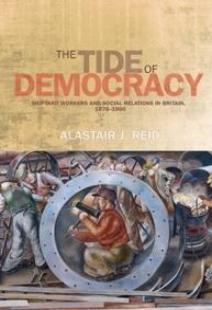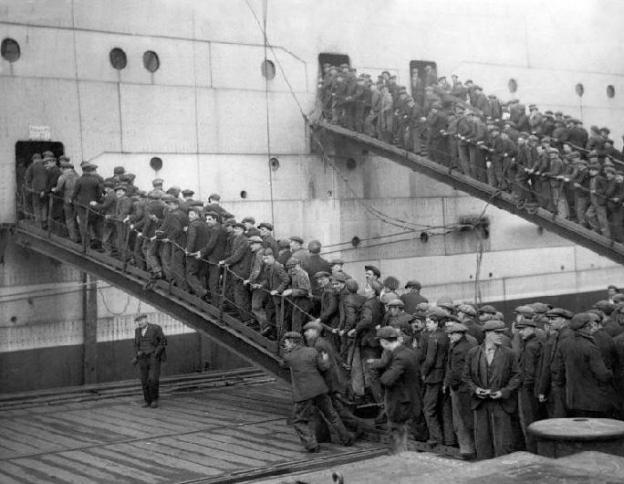Alastair Reid, co-founder of History & Policy, joint Convenor of the Trade Union Forum and Fellow of Girton College, Cambridge
Senate House, University of London, 28 April 2010
Alastair J. Reid, The Tide of Democracy: shipyard workers and social relations in Britain, 1870-1950, Manchester University Press, 2010.
This sturdy craft slipped smoothly from its launch pad at Senate House, University of London at a Contemporary British History seminar on April 28th. Dr Reid's initial focus was on the significance of Britain's historic shipbuilding industry as part of our manufacturing heritage and the lessons of its success (in its late 19th/early 20th century heyday it produced over 60% of world shipping output, and employed over 200,000, mainly on Clydeside and Tyneside). On the basis of his in-depth study, the author argued that shipbuilding demonstrates the economic advantages of clustering small and medium firms together in a district or region. So, about forty family firms each employing an average of 1,000 workers on Clydeside gave the economies of a highly skilled and mobile workforce of 40,000 – good transport links, little stockpiling of supplies (or labour) and cooperative relations with strong craft unions. It also showed how, despite the perennial uncertainties of the market for ships, this cohesion ensured positive business relationships between the shipbuilders, their clients and suppliers. It also involved high levels of input by the craftsmen with fewer managers and greater independence based on mutual trust to the benefit of the quality of the product. These advantages were still seen to be relevant today in the discussion which followed. Parallels were drawn with the IT industry today in the San Francisco Bay area and it may have wider relevance in a revived British manufacturing industry.
But it is his study of the workers, particularly the skilled organized ones in the yards that makes The Tide of Democracy so interesting. It traces the key role which their boilermakers' union played in shipbuilding, in the increasingly important TUC and in the infant Labour Party, in the late 19th and early 20th centuries. At the launch, time did not permit a full exposition of the many interesting themes which Dr Reid's book explores. So, this note is also by way of a signpost to more of them for Forum readers.
Despite the high quality metal-wrighting skills of the boilermakers (the name derived from their original steam-engine boiler-making origins), this was a highly insecure employment with layoffs being the common experience of most workers. These were 'the angle-iron smiths who bent the structural beams and girders; the platers, who cut and shaped the hull and boiler plates; riveters, who joined these beams and plates together by hammering down the ends of hot metal bolts; and caulkers, who rendered the joins in the structure watertight'. They displaced the old wood-working, handicraft journeymen shipwrights. They were also constantly exposed to extremely arduous, inclement, dirty working conditions and uncertain patterns of employment. This was due to an extremely volatile market for ships of all kinds, whether cargo (coal especially on the North East coast), ocean-going luxury liners (Clydeside & Belfast) or warships (Barrow and Birkenhead on the Lancashire coast).
Dr Reid shows that the boilermakers' were wage-earning employees who had to continuously defend their pay and conditions of work from hard-nosed capitalist employers. Through their key metal-working skills and strength of organization, they did carve out special features, for example as to 'how hard and how long to work'. They successfully sought to influence the reproduction of their skills, through the 'closed shop', a strict five-year apprenticeship term and ratios, and collective bargaining at all levels (shipyard, district and national). They consolidated their position as an organized force with a highly providential welfare system. In effect, they helped shape the development of the division of labour, and the system of craft production which prevailed for many decades right into the 20th century. The boilermakers' union reflected and reinforced this strength and their employers had to recognize and come to terms with it. From this strong bargaining position they created their own union and reinforced it.
Why did the shipbuilding employers, usually small to medium-sized family firms (limited liability companies only appeared in the 1890s), accept this 'dictation' (as most other employers of that time would have seen it)? Many did try to impose stricter time-keeping and penalize men for leaving contracts early with a discharge note system, but all such attempts failed. Dr Reid identifies a number of factors. The nature of the shipbuilding industry's product, its 'scale and variety made the overall supervision of assembly virtually impossible, while its complexity made the close control of the pace of work on particular tasks very difficult'. In that environment, the foremen of the squads first had to have the men's respect as superior craftsmen. This included 'the social background for exercising authority and solving personnel problems'. It was the whole squad who decided the pace of work and the quality of the end product, rather than managers. So, the foremen functioned as the squads' virtual 'shop stewards', as much as supervisors and leaders of the production effort and quality control for the employers.
Dr Reid explores each aspect of this craft system of production and the reasons why the often shortsighted and greedy shipbuilding employers left it to the union to weather the frequent periods of unemployment, sickness and disability for their members. In this way, we see how one of the first modern unions grew out of the production process and became so powerful. To view them as a privileged elite labour force, ('labour aristocrats'), dependent on employer 'sops' and 'cosy' deals at the expense of the 'ordinary' workers, he argues, is to entirely misread the historical nature of craft unionism and the capitalism of that period. Warts and all – and they did jealously guard their position in the labour market from employers seeking to substitute less skilled workmen on the cheap – they (and other craft unions like them such as the engineers were the pioneers of the trade union movement.
The Tide of Democracy is a celebration of the central role which craft production skills (manual aptitude, technical knowledge and ability, dexterity and inventiveness) – in engineering as well as shipbuilding – continued to play in the British industrial scene, well into the 20th century. Dr Reid questions the received view of many labour historians, based on Marxist assumptions, that the impact of machinery and division of labour would abolish those craft skills, forcing the workers to become part of a 'proletariat'. He shows pretty conclusively that this did not happen in shipbuilding nor in the heavy branches of engineering (textile-machinery, locomotives and marine engines), where the Amalgamated Society of Engineers (ASE) the other major craft union. He concludes that 'the inherent skill-reducing tendencies in the division of labour and the introduction of machinery were less marked than has usually been assumed'.
Dr Reid's discussion of skills and the threat feared by workers from new machinery, is particularly illuminating. It shows how the boilermakers were able to adapt and not be supplanted by the introduction of rolls, lathes or power drills, riveting tools and so on during the two main periods of machinery introduction of the 1870s-1880s and 1900s-1910s. Their union strategy was to 'follow the machine', i.e., to accept the machinery as part of craft work and recruit the new outside grades of workers into the union viz., the caulkers and riveters' assistants (though not the platers' helpers). By contrast, the ASE, faced with very different work situations in heavy and light engineering (where the rapid extension of standardized production allowed a massive increase in non-craft machinists), adopted a 'craft exclusive' defensive strategy. Dominated by their heavy engineering branches of the Clyde and Tyneside, the ASE members voted continuously not to admit semi-skilled grades until 1926. He argues that this rigid stance weakened them internally (leading to the major breakaway Workers' Union in 1898, which in 1928 merged with the T&GWU, giving that its foothold in engineering). He also attributes the ASE's two major defeats in disputes with the well-organised Engineering Employers' Federation in 1897 and 1922, to this 'craft-exclusive' stance. By contrast, the boilermakers maintained their position in shipbuilding up until the 1950s, and beyond, no doubt also assisted by the more homogenous nature of their industry.
This technological-based examination of the strategy of unions would seem to provide a surer basis for judgements about the early history of the British trade union movement than the more superficial politically-based ('left'/'right') ones often on offer.
That is just Part I of this fascinating new history of British industry. Part II tackles the equally controversial issue of union leadership and democratic government by reference to the United Society of Boilermakers and Iron and Steel Shipbuilders (USBISS) and the strategies and conduct of three of its General Secretaries during the period of the book. In a complete re-examination of the stewardship of their much-maligned first major leader, Robert Knight, from 1871 to 1899, based on the union's continuous records, Reid is convinced that he has been a much 5 misunderstood figure. The fact that he led them to becoming 'one of the most powerful trade unions in the country', does suggest that such a re-assessment is necessary as part of a wider review of the craft unionists' contribution to trade unionism.
This section was not explored at the launch and so that theme will have to be developed in another article. Similarly with Part III, which covers 'The theory and practice of craft politics', and deals with the outlook of the USBISS leaders towards the Liberal and Labour parties, and the political traditions of radical liberalism and socialism. Be prepared to have many assumptions about how the Labour Party came to be and how we characterize the disputes of the 1890s and 1900s ('left'/'right', 'socialism' or 'labourism'), called into question.
The Tide of Democracy tosses a large stone into the pond of trade union historiography, the ripples from which will be felt on many shores.
James Moher and Alastair Reid


